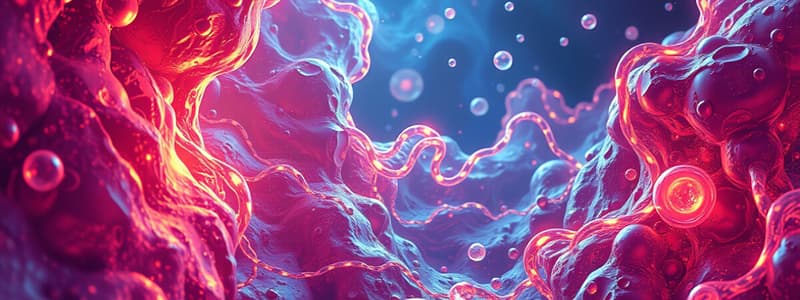Podcast
Questions and Answers
Which polymerization mechanism allows for the synthesis of well-defined macromolecules with controlled chain lengths?
Which polymerization mechanism allows for the synthesis of well-defined macromolecules with controlled chain lengths?
- Conventional polymerization
- Step-growth polymerization
- Chain-growth polymerization
- Living polymerization (correct)
Step-growth and chain-growth polymerizations typically result in polydisperse samples.
Step-growth and chain-growth polymerizations typically result in polydisperse samples.
True (A)
Name one type of controlled radical polymerization technique.
Name one type of controlled radical polymerization technique.
Atom-transfer radical polymerization (ATRP)
Anionic polymerizations require _____ reagents and demanding experimental conditions.
Anionic polymerizations require _____ reagents and demanding experimental conditions.
Match the following polymerization techniques with their characteristics:
Match the following polymerization techniques with their characteristics:
Which of the following is NOT a characteristic of living polymerizations?
Which of the following is NOT a characteristic of living polymerizations?
Controlled radical polymerization techniques are difficult to implement and require high-purity materials.
Controlled radical polymerization techniques are difficult to implement and require high-purity materials.
What is the main advantage of living polymerizations compared to conventional methods?
What is the main advantage of living polymerizations compared to conventional methods?
What technique allows for the preparation of polymers with complex architectures?
What technique allows for the preparation of polymers with complex architectures?
ATRP can be conducted without the use of transition metals.
ATRP can be conducted without the use of transition metals.
Name one living chain-growth method besides CRP.
Name one living chain-growth method besides CRP.
_____ techniques have been significantly optimized over the past few years.
_____ techniques have been significantly optimized over the past few years.
Match the following polymerization techniques with their descriptions:
Match the following polymerization techniques with their descriptions:
Which polymerization method relies on acyclic diene metathesis?
Which polymerization method relies on acyclic diene metathesis?
Ring-opening polymerizations (ROPs) are exclusively chain-growth mechanisms.
Ring-opening polymerizations (ROPs) are exclusively chain-growth mechanisms.
What is one application of dendrimer synthesis?
What is one application of dendrimer synthesis?
Multi-step synthesis can be used to prepare monodisperse _____ molecules.
Multi-step synthesis can be used to prepare monodisperse _____ molecules.
Which of the following is not classified under synthetic polymerization mechanisms?
Which of the following is not classified under synthetic polymerization mechanisms?
What is one disadvantage of conventional step-growth and chain-growth polymerizations?
What is one disadvantage of conventional step-growth and chain-growth polymerizations?
Living polymerizations suppress side reactions such as chain transfer and termination.
Living polymerizations suppress side reactions such as chain transfer and termination.
What type of polymerization techniques are characterized by the ability to synthesize tailor-made macromolecules?
What type of polymerization techniques are characterized by the ability to synthesize tailor-made macromolecules?
Anionic polymerizations require _____ reagents to maintain effectiveness.
Anionic polymerizations require _____ reagents to maintain effectiveness.
Match the following controlled radical polymerization techniques with their characteristics:
Match the following controlled radical polymerization techniques with their characteristics:
Flashcards are hidden until you start studying
Study Notes
Polymerization Mechanisms
- Precise control of molecular structure is crucial for complex materials.
- Synthetic polymers are primarily synthesized via step-growth and chain-growth polymerization methods, established early in polymer science.
- Conventional methods often yield polydisperse samples with less structural definition than biopolymers.
Living Polymerizations
- Living polymerizations allow uniform growth of polymer chains due to slower propagation than initiation, minimizing side reactions.
- Produce well-defined macromolecules with controlled chain lengths and narrow molecular weight distributions.
- Enable fine control over molecular parameters, including chain composition, end groups, topology, and tacticity.
- Particularly effective for synthesizing block copolymers.
Controlled Radical Polymerization (CRP)
- Significant advancements include controlled radical polymerization techniques, e.g., nitroxide-mediated polymerization (NMP), atom-transfer radical polymerization (ATRP), and reversible addition–fragmentation chain-transfer polymerization (RAFT).
- CRP techniques are user-friendly and tolerable to various chemical groups, allowing for tailored macromolecule synthesis.
- Recent ATRP innovations have reduced catalyst quantities and eliminated the need for transition metals through methods like ARGET, ICAR, and SARA.
Other Living Polymerization Methods
- Other notable living polymerization methods include:
- Living cationic polymerization
- Group transfer polymerization (GTP)
- Ring-opening metathesis polymerization (ROMP)
- Ring-opening polymerization (ROP) of cyclic esters and N-carboxyanhydrides.
- Supramolecular polymerizations can also proceed via controlled chain-growth mechanisms.
Step-Growth Polymerization
- Step-growth is useful for precision polymers, exemplified by periodic copolymers.
- Traditional step-growth polymers include polyesters, polyamides, polycarbonates, and polyurethanes.
- Recent developments utilize new chemistries like acyl diene metathesis (ADMET) and copper-catalyzed azide–alkyne cycloaddition (CuAAC).
- Some bifunctional monomers can induce chain-growth mechanisms unexpectedly, broadening synthetic possibilities.
Multi-Step-Growth Synthesis
- Multi-step-growth synthesis allows for the creation of monodisperse polymers with controlled microstructures.
- Dendritic synthesis (convergent or divergent) can yield uniform globular macromolecules suitable for diverse applications.
- Involves stepwise attachment of protected monomers on polymer supports to facilitate purification.
- Initially designed for biopolymer synthesis (e.g., peptides), now also applied to synthetic and sequence-defined macromolecules.
Emerging Techniques and Innovations
- Promising orthogonal approaches have been developed that do not necessitate main-chain protecting groups.
- Synthetic polymers can also be derived through bioinspired/biobased processes such as DNA-templated polymerizations and genetic engineering.
- Some ring-opening polymerizations may start with chain-growth mechanisms, accompanied by equilibrium adjustments during polymerization.
Polymerization Mechanisms
- Precise control of molecular structure is crucial for complex materials.
- Synthetic polymers are primarily synthesized via step-growth and chain-growth polymerization methods, established early in polymer science.
- Conventional methods often yield polydisperse samples with less structural definition than biopolymers.
Living Polymerizations
- Living polymerizations allow uniform growth of polymer chains due to slower propagation than initiation, minimizing side reactions.
- Produce well-defined macromolecules with controlled chain lengths and narrow molecular weight distributions.
- Enable fine control over molecular parameters, including chain composition, end groups, topology, and tacticity.
- Particularly effective for synthesizing block copolymers.
Controlled Radical Polymerization (CRP)
- Significant advancements include controlled radical polymerization techniques, e.g., nitroxide-mediated polymerization (NMP), atom-transfer radical polymerization (ATRP), and reversible addition–fragmentation chain-transfer polymerization (RAFT).
- CRP techniques are user-friendly and tolerable to various chemical groups, allowing for tailored macromolecule synthesis.
- Recent ATRP innovations have reduced catalyst quantities and eliminated the need for transition metals through methods like ARGET, ICAR, and SARA.
Other Living Polymerization Methods
- Other notable living polymerization methods include:
- Living cationic polymerization
- Group transfer polymerization (GTP)
- Ring-opening metathesis polymerization (ROMP)
- Ring-opening polymerization (ROP) of cyclic esters and N-carboxyanhydrides.
- Supramolecular polymerizations can also proceed via controlled chain-growth mechanisms.
Step-Growth Polymerization
- Step-growth is useful for precision polymers, exemplified by periodic copolymers.
- Traditional step-growth polymers include polyesters, polyamides, polycarbonates, and polyurethanes.
- Recent developments utilize new chemistries like acyl diene metathesis (ADMET) and copper-catalyzed azide–alkyne cycloaddition (CuAAC).
- Some bifunctional monomers can induce chain-growth mechanisms unexpectedly, broadening synthetic possibilities.
Multi-Step-Growth Synthesis
- Multi-step-growth synthesis allows for the creation of monodisperse polymers with controlled microstructures.
- Dendritic synthesis (convergent or divergent) can yield uniform globular macromolecules suitable for diverse applications.
- Involves stepwise attachment of protected monomers on polymer supports to facilitate purification.
- Initially designed for biopolymer synthesis (e.g., peptides), now also applied to synthetic and sequence-defined macromolecules.
Emerging Techniques and Innovations
- Promising orthogonal approaches have been developed that do not necessitate main-chain protecting groups.
- Synthetic polymers can also be derived through bioinspired/biobased processes such as DNA-templated polymerizations and genetic engineering.
- Some ring-opening polymerizations may start with chain-growth mechanisms, accompanied by equilibrium adjustments during polymerization.
Studying That Suits You
Use AI to generate personalized quizzes and flashcards to suit your learning preferences.




